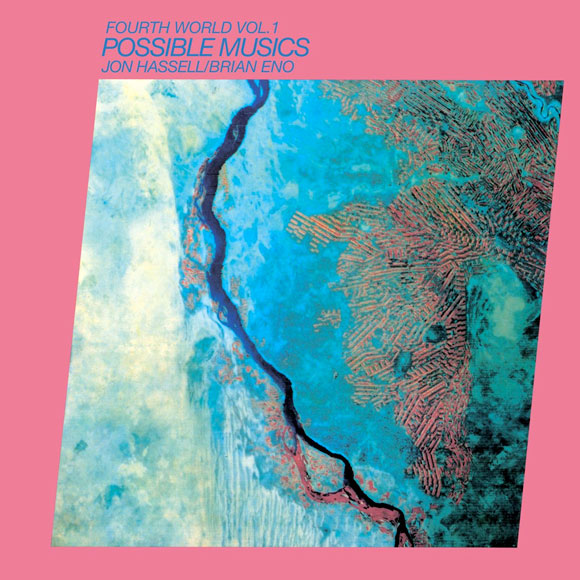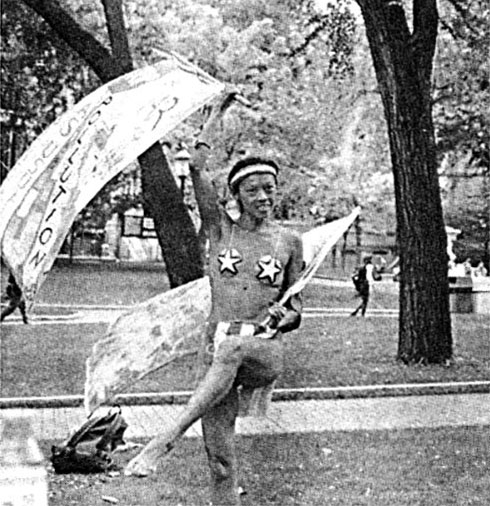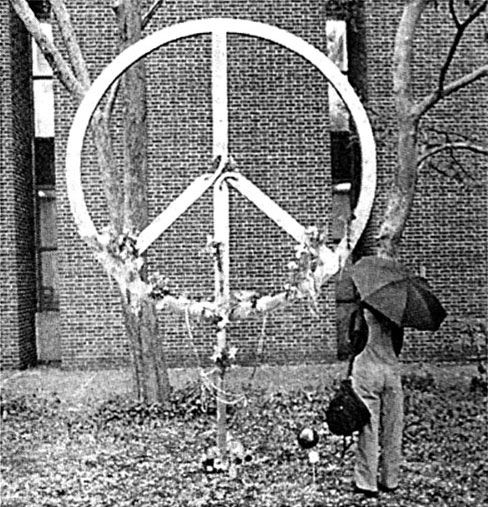Discography | Solo Works
Possible Musics (With Brian Eno)
Fourth World volume 1

Editions EG EEGCD-107
1980 • 45:05
Side one
“Chemistry” (Hassell, Eno) – 6:50
“Delta Rain Dream” (Hassell, Eno) – 3:26
“Griot (Over ‘Contagious Magic’)” (Hassell) – 4:00
“Ba-Benzélé” (Hassell) – 6:15
“Rising Thermal 14° 16′ N; 32° 28′ E” (Hassell, Eno) – 3:05
Side two
“Charm (Over ‘Burundi Cloud’)” (Hassell) – 21:29
Personnel
Jon Hassell – trumpet, Prophet 5 touches on “Delta Rain Dream”, “Aluar” loop on “Rising Thermal”, ARP loops on “Charm”
Brian Eno – background cloud guitars on “Delta Rain Dream”, Prophet 5 “Starlight” background on “Ba-Benzélé”, high altitude Prophet on “Rising Thermal”, rare MiniMoog & treatments on “Charm”
Percy Jones – bass on “Chemistry”
Naná Vasconcelos – ghatam, congas, loop drum
Aïyb Dieng – ghatam, congas
Michael Brook – bass on “Griot”
Paul Fitzgerald, Gordon Philips, Andrew Timar and Tina Pearson – handclaps on “Griot”
Jerome Harris – bass on “Ba-Benzélé”
Night Creatures of Altamira (field recording) on “Rising Thermal”
Jon Hassell—trumpet, pottery drums, Prophet 5, bowl gongs
Brian Eno—drums, bowl gongs & bells
Michael Brook—bass
Miguel Frasconi—bowl gongs
Essay written in 1980 to introduce the idea of Fourth World to the music press:
POSSIBLE MUSICS
SOME ANSWERS TO THE QUESTION, “WHAT ARE SOME OF THE POSSIBLE MUSICS ON THIS PLANET AT THIS TIME?”
I. Fourth World Music
“Fourth World” , that is, beyond “Third World” — a primitive/futuristic sound combining features of world ethnic styles with advanced electronic techniques. In its highest form the blend of influences creates an impression of a new, unified sound.
Some music is “cosmetic” Fourth World . This dots the i’s of conventional musical statements with borrowed flavorings of exotic instruments.
Some music is “covert” Fourth World . In some ways this is the opposite of the cosmetic approach. Here a structural framework of some ethnic music is borrowed and presented with Western orchestration. This gains in prestige the more the audience is unfamiliar with its origins.
Some music is “unconscious” Fourth World . For example, pop music of Asian or African countries which assimilate aspects of Western pop but maintain local color and spirit.
Some music could be called “visionary” Fourth World . This would extrapolate (from knowledge of world musics) into the future and/or past, attempting to present something—a mood, a vision, a special sense of time—in some coherent sound form.
II. Multi-Leveled Music
Mozart, speaking of two of his piano concertos:
“There are particular passages from which connoisseurs alone can derive satisfaction, but still the less learned cannot, I believe, fail to be pleased, even without knowing why”
This reminds us that things communicate at simultaneous levels. Some people think that the more levels a work has or provokes, the “richer” it can be said to be. This is one criterion commonly held to separate “high” and “low” art.
The emergence of significant numbers of art school graduates (familiar with the multi-leveled messages of high art) as makers of new music has changed the largely uni-leveled pop tradition into a forum for multi-leveled, hybrid, sound-images. This cross-fertilization by “outsiders” who create, out of necessity, new approaches to instrumental techniques and formal thinkng, challenges the pre-dispositions of “ schooled” musicians toward more familiar solutions.
Perhaps this breaks the ground for acceptance of more esoteric cross-breeding.
III. Narrow-Band Culture
So far, most of these artpop hybrids have been conceived within a limited framework of choices—a framework of cultural/racial biases whose rear-view goes no further than the emergence of the long-playing record and whose front-view is dictated entirely by the demands of a marketplace where media not only reflect but create attitudes.
A narrow-band culture results in which the range of possible musics is reduced to a set of primary colors with any in-between shade viewed as a failed attempt at being a primary.
IV. “High” (Classical) and “Low” (Pop)
The classical avant-garde has created many “possible musics” over the years. The lack of audience for these efforts is understandable seen in the light of certain shared assumptions about what distinguishes a classic approach from a pop approach.
Consider that in India, Africa and many other cultures (if any separation between classical and popular exists at all), classical music is sensuous, it’s built over highly-inflected (“jungle”) rhythms, improvisation plays a major role, expressing a mood is aprimary goal and it communicates to all classes of people. The popular music often is similar but less rigorously formed.
In Western culture, no form in which improvisation is a major element is considered classical. Further, anything that is openly sensuous and/or uses certain rhythmic inflections or even certain instruments is automatically relegated to some “low” category (jazz, rock, mood music, etc.). This is the equivalent of etiquette rules: Do this, don’t do that – if you want to be visible as a member of a certain class.
Obviously, a kind of cultural racism is at work here which, more often than not, reduces non-European things to “curio” status. Any trend which softens this centuries-old superiority complex (hardening of the categories) should be welcomed.
V. Sincerity and Irony
Generations fed on hypocrisy, self-righteousness, and mock sincerity can’t be blamed too much for an automatic smirk at the word “sincere”. Current “new wave” form cultivates the ironic approach (distanced, clever, solipsistic) as the only allowable response. The ironic playpen can be a lot of fun, but it’s no substitute for the direct transmission and reception of heartfelt messages. The coyote’s howl is heard with deep feeling (if not approached ironically) because it is felt deeply by a creature who knows only how to be itself and say what it means.
Music can be like this but it’s rare.
VI. New Wave
One could hope that certain aspects of “new wave” (proliferation of clubs, black/white musical syntheses, artmusic influences, general thirst for new sounds) are the rumbling s of intelligence to resist strangleholds (corporate and otherwise) on music and to open the windows to a wider range of influences. (Danger: rebellion is packageable for re-sale.) In that sense, Possible Musics might be jargonized as “listening-oriented” new wave music in distinction to “dance-oriented”.
VII. Possible Musics : The Record
In the best of these 45 minutes, a unified Fourth World sound-image is achieved, a new context for instrumental virtuosity is shown possible, levels of profound feeling are touched, and, in general, formula solutions passed over for more adventurous choices.
The title of the extended piece on side B, Charm (over Burundi Cloud) reflects a compositional formula in which the foreground Charm (cf. quark charm, snake charm, sexual charm), eveolves from a backgorund drone consisting of two “frozen” (digitally-trapped to repeat endlessly) sound-moments called Burundi Cloud. This drone “predicts” the textures, colors and limits within which the music might form itself. This idea maps onto the ancient Indian form which prescribes sets of pitches, pitch shapes, ornaments, rhythmic inflections, etc.—and, especially, a specific mood—for each raga.
Finally, the cover art—a satellite photo of an area south of Khartoum (14º 16’ N ; 32º 28’ E) may be seen as a visual correlate of the musical thought: a “primitive” part of the Earth as seen from a space attitude.
©1980 jon hassell

